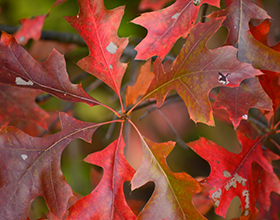 We have been lucky again this autumn, living as we do in the temperate forest biome of Ohio, to witness one of nature’s spectacles, as summer’s green leaves turn to red, orange, and yellow. Now, as the weather cools, those colors are mostly shifting to brown and the branches are quickly losing their leaves. What’s going on here?
We have been lucky again this autumn, living as we do in the temperate forest biome of Ohio, to witness one of nature’s spectacles, as summer’s green leaves turn to red, orange, and yellow. Now, as the weather cools, those colors are mostly shifting to brown and the branches are quickly losing their leaves. What’s going on here?
Scientists address those sorts of questions with two kinds of answers. One approach looks at proximate causes: what are the mechanisms that cause leaves to change color and fall off the tree? The other looks at ultimate causes: why do these phenomena occur, how do they fit into the life strategy of the tree?
The proximate mechanisms behind autumnal leaf transitions involve two main sets of processes. One of these is responsible for color change. Leaves are green because they contain chlorophyll, a pigment molecule that absorbs mostly blue and red light (so that we see the reflected green) and uses that light energy to begin the process of photosynthesis, yielding sugar that fuels plant cells. As sunshine lessens in autumn and temperatures fall, photosynthesis slows and there is less need for chlorophyll. So, the leaf begins to digest the molecules of chlorophyll and to recycle the components for other uses. As the abundant chlorophyll degrades, other pigments in the leaves become visible. Carotenoids, which absorb blue/green light for photosynthesis and also protect leaves against damage from excessive light, provide yellow and orange colors in autumn leaves in trees like beeches and tulip trees. Anthocyanins, which protect leaves against a variety of stresses, appear red as in some oaks and maples.
The second set of mechanisms in autumn trees results in leaf fall (abscission). That process is regulated by hormones, probably auxin and ethylene, whose abundance change seasonally. Under hormonal influence, the leaf digests the cell walls in the abscission zone at the base of each leaf petiole. As those cell walls deteriorate, the bond of leaf to tree weakens, and eventually the leaf falls off.
Those proximate causes define mechanisms. But what are the ultimate causes of autumn leaf transitions: not HOW, but WHY do trees give up on chlorophyll and shed their leaves each autumn? The bottom line is that leaves impose costs. Even during summer, when photosynthesis feeds the tree, making and sustaining leaves and chlorophyll is expensive. Moreover, leaves are sites of substantial water loss, and during winter they may accumulate snow that creates risk of limb breakage. Thus, during darker, colder months, when tree growth is slowed, leaves present more of a burden than a benefit, and they are released.
And yet, one of the beautiful sights on a clear winter day’s walk in the woods is the brown leaves of beech trees coated in snow and glowing backlit by the low-lying sun. The implication, of course, is that beech trees retain leaves during winter. And indeed, beeches, along with oaks and some other species, are “marcescent”: they retain at least some of their leaves, usually on immature parts of the tree, into the cold seasons. Why?
Perhaps the unpalatable, dry winter leaves protect next year’s buds from being eaten by browsers like deer, or from the drying winds of winter. Or maybe the ability of winter leaves to trap snow actually benefits the tree by retaining water that supports growth upon springtime thaw.
All living organisms incorporate tradeoffs. Any trait that allows an organism to survive and reproduce will be passed on to the offspring, even if that trait proves sub-optimal in some circumstances. So it is with leaves. Leaves are the sites of vital photosynthesis, but also of desiccating water loss. Leaves may protect a tree from winter browsing, but they also cost energy to build and maintain. As the diversity of North American trees evolved—Ohio forests contain more than 100 species—different species succeeded with different strategies. The result is that we now see the green leafy forests of summer, the multi-colored foliage of autumn, and the shimmering dead leaves of winter. As Simon and Garfunkel put it in their song A Hazy Shade of Winter, “Seasons change with the scenery, weaving time in a tapestry.”
Enjoy!
